Adventures
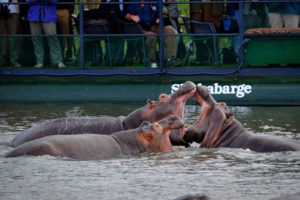 St. Lucia offers you an incredible number of activities and things to do in the area. If you are a nature lover then this is the place to be. Nature photographer, Instagrammer, videographer, blogger – be sure to have your camera ready. We have everything – beautiful beaches, lush coastal forests, dunes, savannah grasslands, wetlands, sunsets over the lake, leatherback and loggerhead turtles laying eggs in the summer, the whale migration in the winter months, but also the extensive game and birdlife found in St Lucia and the nature reserve the town is nestled in.
St. Lucia offers you an incredible number of activities and things to do in the area. If you are a nature lover then this is the place to be. Nature photographer, Instagrammer, videographer, blogger – be sure to have your camera ready. We have everything – beautiful beaches, lush coastal forests, dunes, savannah grasslands, wetlands, sunsets over the lake, leatherback and loggerhead turtles laying eggs in the summer, the whale migration in the winter months, but also the extensive game and birdlife found in St Lucia and the nature reserve the town is nestled in.
Here is a short list that visitors to St Lucia needs to keep in mind when planning their visit. Feel free to contact us with any questions. We will gladly assist in booking tours and safaris for our guests, at no extra charge.
Boat Cruise on the St. Lucia Estuary.
One of highlights of a visit to St Lucia. A slow cruise on the lake to see not only the hippos and crocodiles, but also some of the 495 species of birds and other wildlife that make the lake their home. A fantastic way to immerse yourself in this wetland ecosystem.
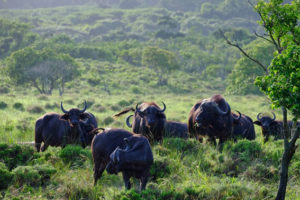 iSimangaliso Wetland Park – Eastern & Western Shores
iSimangaliso Wetland Park – Eastern & Western Shores
The Zulu word iSimangoliso means miracle, or wonder, which aptly describes this beautiful wetland park, which has more of a tropical Jurassic Park atmosphere than its neighbouring Savannah grassland game parks. The park has 4 of the Big 5, and rather than dinosaurs you will find rhinos, buffalo, elephant and leopard (the most elusive of our Big 5), and an amazingly rich diversity of wildlife. A self-drive through the park or a guided Safari will introduce you to tidal pools at Mission Rock, glorious expanses of deserted beach at Cape Vidal, Banghazi lake, and a myriad of bird species, insects, buck, zebra, wildebeest, and hippos to name a few. There are several gravel roads (easily accessible with sedan cars) through the different ecosystems, short walks to hides, and panoramic look out points with 360-degree views of the Indian ocean, rolling vegetated dunes, and Lake St. Lucia.
 iSimangaliso Wetland Park – Eastern & Western Shores
iSimangaliso Wetland Park – Eastern & Western Shores
The Zulu word iSimangoliso means miracle, or wonder, which aptly describes this beautiful wetland park, which has more of a tropical Jurassic Park atmosphere than its neighbouring Savannah grassland game parks. The park has 4 of the Big 5, and rather than dinosaurs you will find rhinos, buffalo, elephant and leopard (the most elusive of our Big 5), and an amazingly rich diversity of wildlife. A self-drive through the park or a guided Safari will introduce you to tidal pools at Mission Rock, glorious expanses of deserted beach at Cape Vidal, Banghazi lake, and a myriad of bird species, insects, buck, zebra, wildebeest, and hippos to name a few. There are several gravel roads (easily accessible with sedan cars) through the different ecosystems, short walks to hides, and panoramic look out points with 360-degree views of the Indian ocean, rolling vegetated dunes, and Lake St. Lucia.
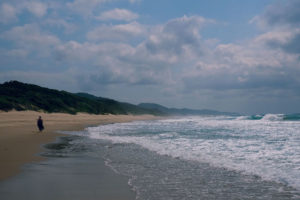 Cape Vidal.
Cape Vidal.
Situated at the very end of the Eastern Shores portion of Isimangoliso Park is a piece of paradise, Cape Vidal, a magnificent beach stretching all the way to Mozambique. It is a renowned fishing location, and a snorkeling spot at low tide, and if that is not your thing it is a haven to soak up the unique bush and beach experience in a sheltered bay under the African sun. As one of the top 10 beaches in the world, Cape Vidal is the perfect spot for a picnic – bring your own food and drinks as there are not many facilities inside the park. Just watch those pesky monkeys who will help relieve you of your picnic in the blink of an eye!
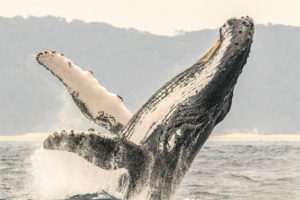 Meeting the gentle ocean giants – whale watching excursions.
Meeting the gentle ocean giants – whale watching excursions.
Experience the thrill of a surf launch off St Lucia beach to view the awe-inspiring sight of the Humpback Whales as they migrate down from Madagascar to the Antarctic from June to November. The sight of whale’s breaching, slapping their tails, or just casually sailing along, or dozing on this two hour boat based whale watching excursion is an experience of a life time. Often, besides magnificent whale displays, you may well see other marine life such as whale sharks, game fish, dolphins, turtles, and numerous ocean birds.
 Meeting the gentle ocean giants – whale watching excursions.
Meeting the gentle ocean giants – whale watching excursions.
Experience the thrill of a surf launch off St Lucia beach to view the awe-inspiring sight of the Humpback Whales as they migrate down from Madagascar to the Antarctic from June to November. The sight of whale’s breaching, slapping their tails, or just casually sailing along, or dozing on this two hour boat based whale watching excursion is an experience of a life time. Often, besides magnificent whale displays, you may well see other marine life such as whale sharks, game fish, dolphins, turtles, and numerous ocean birds.
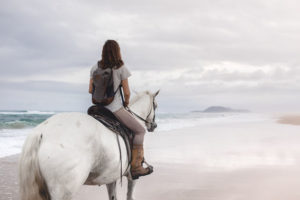 Horse riding with Bhangazi Horse Safaris.
Horse riding with Bhangazi Horse Safaris.
Bhangazi Horse Safaris offers a unique horse-riding experience in the iSimangaliso Wetland Park. It is a great way to explore the wildlife in the area, as a rider on horseback does not threaten the game. You are seen as one of them, thus allowing you to move in close to animals such as zebra, wildebeest, bushbuck, warthog, duiker, waterbuck and impala. Glorious Beach rides can also be arranged along the breathtaking pristine and unscathed beaches of St Lucia with Mapelane (the tallest vegetated dune in Africa, and the 2nd tallest in the world) as a backdrop.
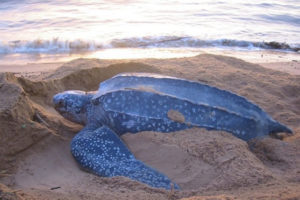 Night excursions to witness the turtles nesting on sandy beaches.
Night excursions to witness the turtles nesting on sandy beaches.
The expansive beaches of the iSimangaliso Wetland Park, North of Cape Vidal are one of the last remaining major nesting sites for Leatherback and Loggerhead turtles. They come ashore at night every year from November to lay their eggs in the sand. Seventy days later, from early January until about the end of February the eggs hatch and the young turtles run the gauntlet of aerial and ground predators towards the relative safety of the water. Even here, they are an easy meal for a number of predators, and it is estimated that only four of every 1000 hatchlings actually reach maturity. With such low survival rates and the loss of significant areas of safe nesting grounds worldwide, iSimangaliso in St Lucia is a haven for these vulnerable species. The added bonus of course is the night game drive from St Lucia to Cape Vidal before driving onto the beach up towards Sodwana in search of nesting turtles and hatchlings.
 Night excursions to witness the turtles nesting on sandy beaches.
Night excursions to witness the turtles nesting on sandy beaches.
The expansive beaches of the iSimangaliso Wetland Park, North of Cape Vidal are one of the last remaining major nesting sites for Leatherback and Loggerhead turtles. They come ashore at night every year from November to lay their eggs in the sand. Seventy days later, from early January until about the end of February the eggs hatch and the young turtles run the gauntlet of aerial and ground predators towards the relative safety of the water. Even here, they are an easy meal for a number of predators, and it is estimated that only four of every 1000 hatchlings actually reach maturity. With such low survival rates and the loss of significant areas of safe nesting grounds worldwide, iSimangaliso in St Lucia is a haven for these vulnerable species. The added bonus of course is the night game drive from St Lucia to Cape Vidal before driving onto the beach up towards Sodwana in search of nesting turtles and hatchlings.
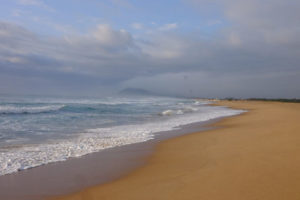 St. Lucia Beach.
St. Lucia Beach.
This glorious subtropical beach experiences around 300 days of sunshine a year. The gorgeous golden sands are peppered with what looks like sprinklings of volcanic sand, which is in actual fact heavy minerals. It is these dark heavy minerals which make these unending stretches of beach ideal for nesting turtles selecting who these shores for their nesting grounds because the heavy minerals in the sand help keep their eggs warm. Whether it is walking, swimming on Main Beach, fishing or just soaking up the sun, St Lucia beach is idyllic; with the rustling tropical vegetation behind you and the crashing surf in front of you stretching as far as the eye can see in both directions.
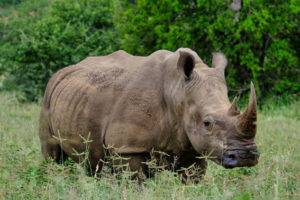 10. Hluhluwe- Imfolozi Game Park.
10. Hluhluwe- Imfolozi Game Park.
The name pronounced shloo-shloo-wee-om-fa-low-zee is a mouthful, but you get used to it once you understand how to pronounce the sounds. This park is the oldest game park in South Africa and forms the 5th part of the iSimangoliso coastal ecosystem. Its savannah grassland is ideal for spotting the Big 5 and only an hour’s drive from St Lucia. Three rivers flow through the park. The Black and White iMfolozi snake their way through a series of valleys in the southern section leaving rich riverine vegetation to accompany drier woodland, grassy plains, and open savannah for spotting wildlife.
 10. Hluhluwe- Imfolozi Game Park.
10. Hluhluwe- Imfolozi Game Park.
The name pronounced shloo-shloo-wee-om-fa-low-zee is a mouthful, but you get used to it once you understand how to pronounce the sounds. This park is the oldest game park in South Africa and forms the 5th part of the iSimangoliso coastal ecosystem. Its savannah grassland is ideal for spotting the Big 5 and only an hour’s drive from St Lucia. Three rivers flow through the park. The Black and White iMfolozi snake their way through a series of valleys in the southern section leaving rich riverine vegetation to accompany drier woodland, grassy plains, and open savannah for spotting wildlife.
Birding & Walking trails.
There are numerous walking trails for you to stretch those legs after sitting in a vehicle all day. A short walk on the iGwalagwala Trail, close to the Estuary banks is a leisurely 1.5 kilometre stroll and is suitable for all ages. It leads through the lush coastal forest next to the St. Lucia Estuary with plenty of bird spotting opportunities.
The Iphiva walking trail is a 3-hour walk, which starts near to the Crocodile Centre and continues along the St. Lucia Estuary. It leads on through open grassland and floodplains into the dense coastal dune forest, a hotspot for birders boasting a diverse range of birds such as the Blue-cheeked Bee-eater, Red-breasted swallow, Rosy-throated longclaw and Southern Banded Snake-Eagle to name only a few. Small antelope, zebra, warthog, and wildebeest are frequently sighted in the less dense areas of the trail. Keep your eyes open for crocodiles in the pans and hippos out of the water.
The Boardwalk at the Estuary mouth starting at the end of the road going down to the Ski-boat Club we find this unique trail down to the beach. This walk runs along the water’s edge onto the sandy beach at the mouth. The wooden walkway is the perfect spot to experience the estuary environment. Meandering through mangroves and along the edge of reed beds, visitors can explore these estuary habitats from a slightly elevated vantage point that provides not only a better view of the water, but also an element of safety from chance encounters with hippos and crocodile along the water’s edge.
Should you wish, we can arrange for a birding guide to accompany you.
And of course, do not forget the village hippos, locally known as “The Townies” – the legends are true, they really do graze on our lawns at night, and you may well see them while walking (or driving) to dinner on the main street! Most of all be sensible when you encounter our less friendly local residents – no hugs or selfies, that Instagram shot just isn’t worth it, they BITE!



